The Moroccan tagine is a stew named after the conical earthenware vessel in which it’s traditionally prepared, but it’s more of a concept than a dish, really, embracing everything from courgettes to camel hump. As devoted Archers fans will recall, the tagine itself, as much a portable oven as a pot, is not the easiest thing to store, so Jennifer Aldridge may be relieved to hear that, according to Nargisse Benkabbou, most modern Moroccans use a casserole instead.
As Benkabbou explains in her book Casablanca, there are four main categories of tagine, regardless of the main ingredient: mqualli, with olive oil, turmeric, ginger and saffron; mhammer, with butter, paprika and cumin; mchermel, with herby, garlicky chermoula; and one with tomato, cumin and paprika. “Each can be customised with seasonal vegetables, dried fruits, preserved lemons, olives and nuts”.
The tagine, it seems, is a very adaptable dish, deserving of a whole series of columns. Here, having already tackled the vibrant yellow chicken mqualli with preserved lemons and olives, I’ll be looking at a sweeter, fruitier version with lamb, still aromatic with spice, but altogether richer and darker and stickier.
The meat
Focusing on lamb does not narrow the field much: Zette Guinaudeau-Franc, whose 1958 book Fes Vu par sa Cuisine, was recommended to me by both Anissa Helou and Diana Henry, calls simply for mutton and Benkabbou for neck fillets, “or any type of stewing meat”, Paula Wolfert goes for bone-in leg in The Food of Morocco, Nigella Lawson for boneless leg in Nigella Christmas, Claudia Roden for boned shoulder, and Robert Carrier (who kept what the Guardian obituary describes as an “ornately restored mansion” in Marrakech) shoulder or cutlets.
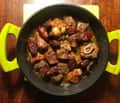
They all work, of course, but my testers agree that lean leg seems like a waste when cheaper shoulder or neck gives a juicier result. I end up making my perfect tagine with goat for extra flavour (indeed, Jeff Koehler includes a kid recipe in Morocco: A Culinary Journey). But hogget, mutton and lamb will do just fine – and if you get it from a butcher, ask them to chuck in the bones, too, because they add an extra savoury note to Wolfert’s dish. If not, given the difficulties of obtaining decent lamb stock, I’d recommend browning the meat, as Henry and Lawson do. Henry tells me she’s aware this isn’t the usual practice in Morocco, but says “I just think it tastes delicious” – and I agree. Be careful not to cut the meat too small, though, to avoid it drying out: you don’t need to get a ruler out, but 4cm chunks are perfect.
(Lamb-phobics note that John Gregory-Smith recommends beef shin in his gloriously rich-looking version in Honey & Spice for “an opulent tagine … perfect for a special occasion”.)
The spices
Guinaudeau-Franc keeps things pretty simple, using just ginger, black pepper, cinnamon and saffron – which may not sound simple until you hear that Benkabbou’s dish contains coriander, cumin, turmeric, ginger, smoked paprika, black pepper, and cayenne pepper. We can taste the difference: Guinaudeau-Franc’s is straightforwardly warming, Benkabbou’s more delicate and complex.

Both prove popular, but I’m sure I’m not alone in being put off by long ingredients lists, so I’ve decided to err towards the simpler end of spicing. If you’re attracted by the idea of a more nuanced result, with smoky, earthy notes to balance the sweetness of the fruit, then I’d point you towards Benkabbou’s recipe.
Fruit and veg
Onions are a must – if you’d really like to keep things traditional, as well as make life easy for yourself at the same time, copy Guinaudeau-Franc and chuck them in whole and raw, and remove and discard before serving. You will, however, miss out on the sweetness that cooked onion brings to the party, so I suggest sauteeing them and then, like Wolfert, adding them to the pot in two stages, so some retain their texture in the finished dish. It’s not much more work, and I think it’s worth it.

Wolfert, Benkabbou and Henry all put garlic in their tagines, adding a more savoury note that is a nice optional extra, though I don’t think my recipe needs it to be delicious. Instead, I’m going to pack it full of fruit. Recipes abound for fruit tagines, some using fresh (Gregory-Smith has one with quince, Koehler pear), many with the dried variety: Koehler suggests figs, Guinaudeau-Franc prunes, Roden and Lawson dates and Benkabbou apricots and dates – a combination that seems to me to be the nicest, because the intense, sugary sweetness of the dates is balanced by the sharper apricots, but really, use whatever you like. Labour-saving cooks could add the fruit whole, but we all prefer it roughly chopped, so that it breaks down into the gravy, rather than plonked on top and crisped in the oven, as in Wolfert’s recipe.
A spoonful of honey is an optional extra: I’m with Roden in that I think it makes the dish too sweet, but you’ll know your own taste. The same goes for Guinaudeau-Franc’s orange-blossom water; not everyone is keen on the floral flavour, but if you’re a fan, stick in a splash at the end of cooking. And if you’re into sweet-and-sour, then Lawson’s pomegranate juice in place of water is a nice twist.

To finish
Most of the tagines I try are finished with a scattering of flaked almonds or sesame seeds fried in a little butter, which we all enjoy for the crunch they bring; the freshness of Benkabbou’s coriander is also welcome. If you’d really like to impress, Lawson’s red onion and pomegranate salsa is a more involved but lovely pairing, and brings a flash of colour to the plate, too.
Tagines are apparently generally served with flatbreads, rather than couscous, but in the privacy of your own home, you may, of course, do whatever you like.
Perfect lamb tagine
Prep 10 min
Cook 2 hr 45 min
Serves 4
2 tbsp olive oil or butter, plus 1 knob extra for frying the almonds
1 large onion, peeled and finely sliced
600g boneless shoulder of mutton, goat or lamb (plus bones, if available), cut into roughly 4cm cubes
½ tsp ground black pepper
1 tsp ground ginger
¼ tsp saffron threads, soaked in 2 tbsp warm water
1 cinnamon stick
1 small bunch fresh coriander
200g dates
100g dried apricots
2 tbsp flaked almonds
Melt the oil or butter in a shallow, heavy-based pan (or, indeed, a tagine) over a medium-low heat, then add the onion and cook until soft and golden. Scoop the onion out on to a plate, turn up the heat, then add the meat, in batches, if necessary, and brown well on all sides.
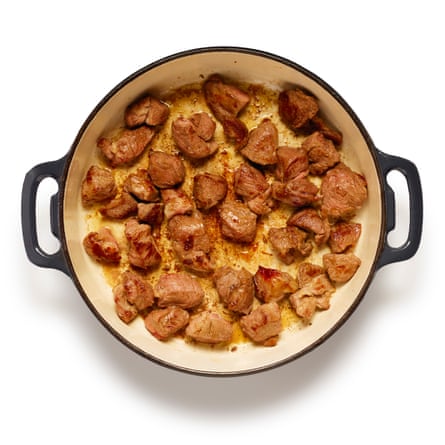
Stir the ground spices into the saffron water, then tip into the pot along with the cinnamon stick. Cook briefly until aromatic, then add most of the coriander, half the onion and 300ml cold water, scraping the bottom of the pan to dislodge any crusty bits of meat or spice. Add the bones, if you’ve got them, bring to a simmer, then cover tightly. Turn down the heat to very low and cook for about two hours, or until the meat is very tender.
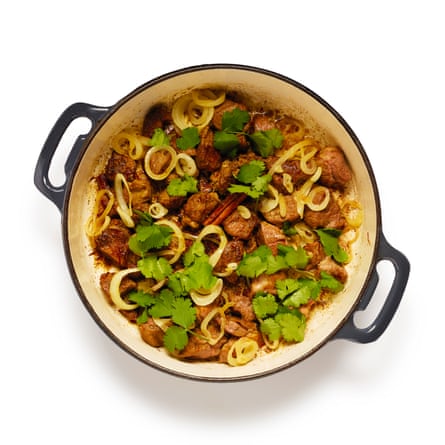
Meanwhile, stone the dates, if necessary, and roughly chop with the apricots. Once the meat is soft, fish out the bones, coriander and cinnamon stick, if you can, then add the fruit to the pan and simmer, uncovered, for about 30 minutes more, until you have a thick sauce.
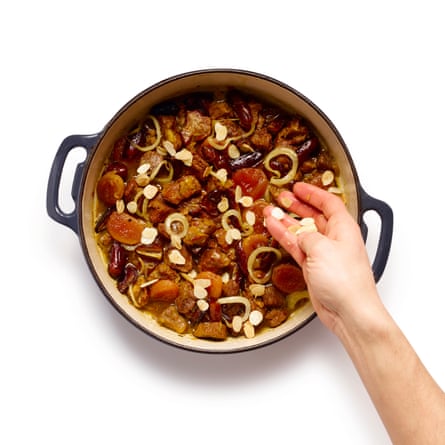
In a small frying pan, fry the almonds in hot the butter until toasted, then tip out to cool.
Stir the remaining onions into the tagine, and taste for seasoning. Garnish with the almonds and remaining coriander, roughly chopped, and serve with flatbreads or, if you prefer, hot, buttered couscous.
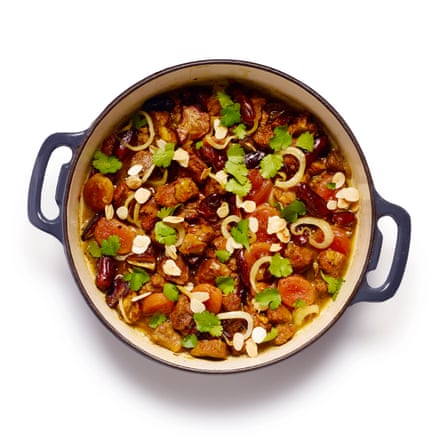
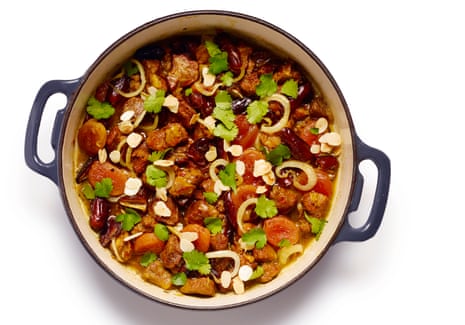
Comments (…)
Sign in or create your Guardian account to join the discussion